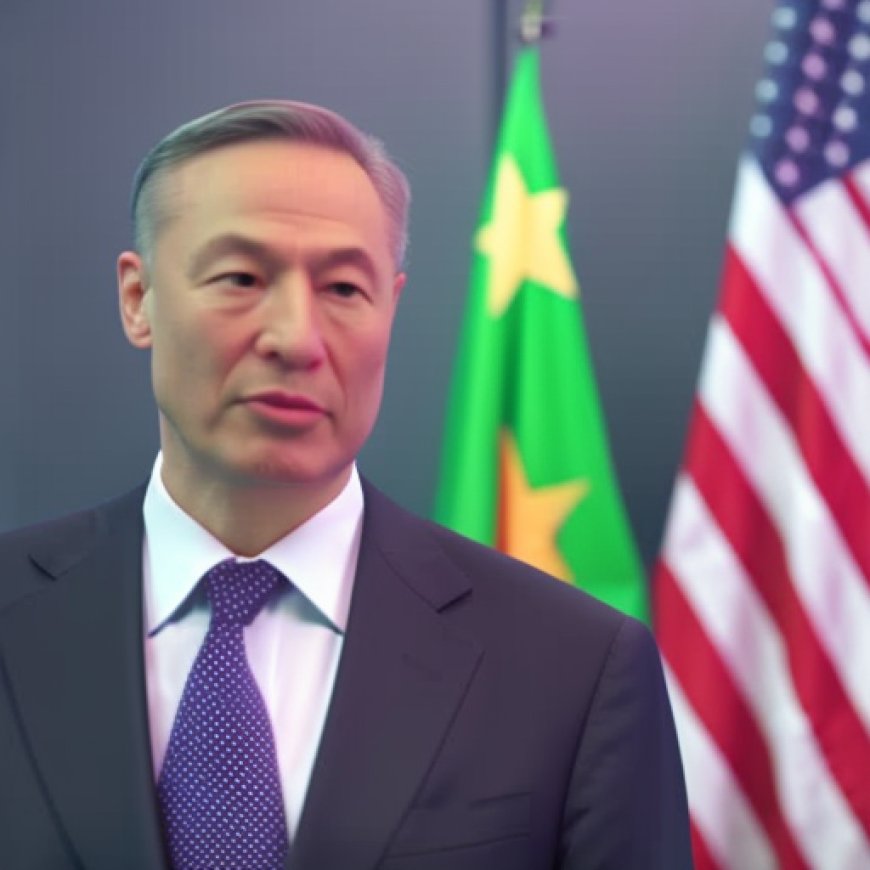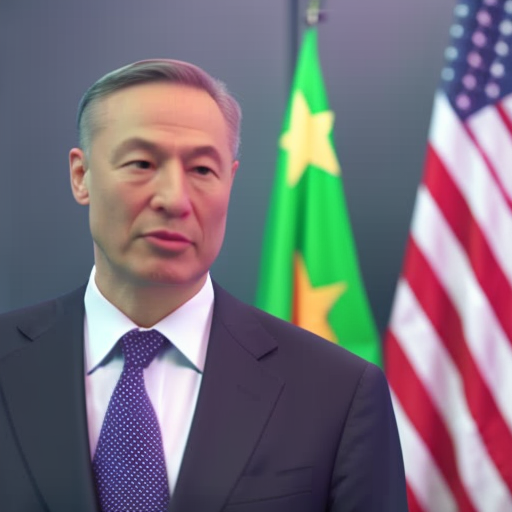US and China agree to start new talks on ‘balanced’ economic growth
US and China agree to start new talks on 'balanced' economic growth FRANCE 24 English


The United States and China Agree to Hold Intensive Exchanges on Balanced Growth
The United States and China have agreed to hold “intensive exchanges on balanced growth”, according to a statement from the US Treasury Department. The agreement comes after two days of talks between US Treasury Secretary Janet Yellen and her Chinese counterpart He Lifeng in Guangzhou.
Sustainable Development Goals (SDGs)
- No Poverty
- Zero Hunger
- Good Health and Well-being
- Quality Education
- Gender Equality
- Clean Water and Sanitation
- Affordable and Clean Energy
- Decent Work and Economic Growth
- Industry, Innovation, and Infrastructure
- Reduced Inequalities
- Sustainable Cities and Communities
- Responsible Consumption and Production
- Climate Action
- Life Below Water
- Life on Land
- Peace, Justice, and Strong Institutions
- Partnerships for the Goals
Background
The planned talks between the United States and China mark the latest step forward in joint efforts to stabilize rocky ties between the world’s two leading economies since a meeting between Presidents Joe Biden and Xi Jinping last November.
“These exchanges will facilitate a discussion around macroeconomic imbalances, including their connection to overcapacity, and I intend to use this opportunity to advocate for a level playing field for American workers and firms,” said Yellen in a separate statement on Saturday.
Overcapacity is seen by the United States as huge Chinese subsidies — to industries such as solar, electric vehicles, and batteries — risking a surplus of cheap goods that threatens those sectors elsewhere.
After warning on Friday that China’s overcapacity could pose risks to economies around the world, Yellen discussed the issue for “more than two hours” during Saturday morning talks with He.
Beijing has dismissed concerns over its vast state support for industry, last month condemning an EU probe into its subsidies for EVs as “protectionism” and part of a Western effort to politicize international trade.
But Yellen suggested Saturday that some progress had been made in getting the two sides to see eye-to-eye.
“I think the Chinese realize how concerned we are about the implications of their industrial strategy for the United States, for the potential to flood our markets with exports that make it difficult for American firms to compete, and that other countries have the same concern,” said Yellen.
“It’s not going to be solved in an afternoon or a month,” she said, hailing the agreement for fresh talks as providing “a structured way in which we can continue to listen to one another and see if we can find a way forward that will avoid conflict”.
Upcoming Visit to Beijing
Yellen will now head north to Beijing, where she will have a two-day visit involving more high-level discussions with Chinese leaders.
This visit to China — her second in the past year — comes as Washington and Beijing feud over everything from access to advanced technology, the self-ruled island of Taiwan, and video app TikTok.
The US Treasury Secretary also warned Saturday of “significant consequences” if Chinese firms aid Russia, whose February 2022 invasion of Ukraine has not been condemned by Beijing.
“Secretary Yellen emphasized that companies, including those in the PRC, must not provide material support for Russia’s war against Ukraine, including support to the Russian defense industrial base, and the significant consequences if they do so,” the US Treasury said in a statement, referring to the People’s Republic of China.
“We’ve been clear with China that we see Russia as gaining support from goods that China, Chinese firms are supplying to Russia,” Yellen told journalists in Guangzhou.
“Neither of us want this to be an issue with our bilateral relationship. So we’re working together,” she said.
Shared Challenges
The US Treasury readout also said the two sides had made a “commitment to work together on shared challenges, including climate finance and debt issues in low-income and emerging economies”.
They agreed to explore ways to step up a joint crackdown on money laundering through exchanges under a US-China “financial working group”, with a first meeting to be held “in the coming weeks”, the statement said.
The exchange comes after repeated calls by Washington for Beijing to stem the flow of fentanyl and related precursor chemicals from plants in China, often sold via illicit financial transactions to buyers in North America.
Biden and Xi agreed to cooperate on the issue of drug trafficking during their summit in November, with the two governments holding several related working meetings since then.
Relations have stabilized somewhat since the two top leaders met in San Francisco for talks that both sides described as a qualified success.
Yellen’s July 2023 visit helped restart dialogue after a period of heightened tensions, notably over Taiwan, and culminated in the launching of bilateral working groups on economic and financial policy.
US Secretary of State Antony Blinken is also expected to make another China trip in the coming weeks, a sign that both sides are returning to more routine engagements.
(AFP)
SDGs, Targets, and Indicators in the Article
-
SDG 8: Decent Work and Economic Growth
- Target 8.1: Sustain per capita economic growth in accordance with national circumstances and, in particular, at least 7% gross domestic product (GDP) growth per annum in the least developed countries.
- Indicator 8.1.1: Annual growth rate of real GDP per capita.
-
SDG 9: Industry, Innovation, and Infrastructure
- Target 9.1: Develop quality, reliable, sustainable, and resilient infrastructure, including regional and transborder infrastructure, to support economic development and human well-being, with a focus on affordable and equitable access for all.
- Indicator 9.1.1: Proportion of the rural population who live within 2 km of an all-season road.
-
SDG 12: Responsible Consumption and Production
- Target 12.2: By 2030, achieve the sustainable management and efficient use of natural resources.
- Indicator 12.2.1: Material footprint, material footprint per capita, and material footprint per GDP.
-
SDG 13: Climate Action
- Target 13.2: Integrate climate change measures into national policies, strategies, and planning.
- Indicator 13.2.1: Number of countries that have communicated the strengthening of institutional, systemic, and individual capacity-building to implement adaptation, mitigation, and technology transfer.
-
SDG 16: Peace, Justice, and Strong Institutions
- Target 16.4: By 2030, significantly reduce illicit financial and arms flows, strengthen the recovery and return of stolen assets, and combat all forms of organized crime.
- Indicator 16.4.1: Total value of inward and outward illicit financial flows (in current United States dollars).
Table: SDGs, Targets, and Indicators
| SDGs | Targets | Indicators |
|---|---|---|
| SDG 8: Decent Work and Economic Growth | Target 8.1: Sustain per capita economic growth in accordance with national circumstances and, in particular, at least 7% gross domestic product (GDP) growth per annum in the least developed countries. | Indicator 8.1.1: Annual growth rate of real GDP per capita. |
| SDG 9: Industry, Innovation, and Infrastructure | Target 9.1: Develop quality, reliable, sustainable, and resilient infrastructure, including regional and transborder infrastructure, to support economic development and human well-being, with a focus on affordable and equitable access for all. | Indicator 9.1.1: Proportion of the rural population who live within 2 km of an all-season road. |
| SDG 12: Responsible Consumption and Production | Target 12.2: By 2030, achieve the sustainable management and efficient use of natural resources. | Indicator 12.2.1: Material footprint, material footprint per capita, and material footprint per GDP. |
| SDG 13: Climate Action | Target 13.2: Integrate climate change measures into national policies, strategies, and planning. | Indicator 13.2.1: Number of countries that have communicated the strengthening of institutional, systemic, and individual capacity-building to implement adaptation, mitigation, and technology transfer. |
| SDG 16: Peace, Justice, and Strong Institutions | Target 16.4: By 2030, significantly reduce illicit financial and arms flows, strengthen the recovery and return of stolen assets, and combat all forms of organized crime. | Indicator 16.4.1: Total value of inward and outward illicit financial flows (in current United States dollars). |
Analysis
The article addresses or connects to several Sustainable Development Goals (SDGs) and their respective targets:
SDG 8: Decent Work and Economic Growth
The article discusses the talks between the United States and China regarding macroeconomic imbalances and overcapacity in industries such as solar, electric vehicles, and batteries. This relates to SDG 8, which aims to promote sustained, inclusive, and sustainable economic growth, full and productive employment, and decent work for all. The specific target mentioned is Target 8.1, which focuses on sustaining per capita economic growth. The indicator that can be used to measure progress towards this target is Indicator 8.1.1, which tracks the annual growth rate of real GDP per capita.
SDG 9: Industry, Innovation, and Infrastructure
The article mentions the issue of overcapacity in Chinese industries and the potential flooding of markets with cheap exports. This connects to SDG 9, which aims to build resilient infrastructure, promote inclusive and sustainable industrialization, and foster innovation. The specific target mentioned is Target 9.1, which focuses on developing quality, reliable, sustainable, and resilient infrastructure. The indicator that can be used to measure progress towards this target is Indicator 9.1.1, which measures the proportion of the rural population living within 2 km of an all-season road.
SDG 12: Responsible Consumption and Production
The article discusses the need for sustainable management and efficient use of natural resources to address overcapacity and its implications. This relates to SDG 12, which aims to ensure sustainable consumption and production patterns. The specific target mentioned is Target 12.2, which focuses on achieving the sustainable management and efficient use of natural resources. The indicator that can be used to measure progress towards this target is Indicator 12.2.1, which measures the
Behold! This splendid article springs forth from the wellspring of knowledge, shaped by a wondrous proprietary AI technology that delved into a vast ocean of data, illuminating the path towards the Sustainable Development Goals. Remember that all rights are reserved by SDG Investors LLC, empowering us to champion progress together.
Source: france24.com

Join us, as fellow seekers of change, on a transformative journey at https://sdgtalks.ai/welcome, where you can become a member and actively contribute to shaping a brighter future.







